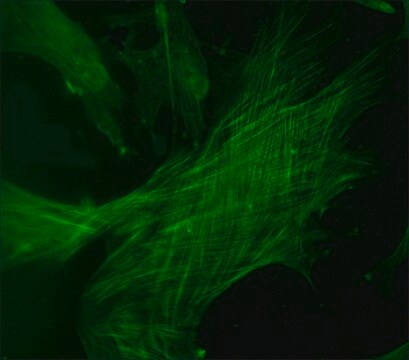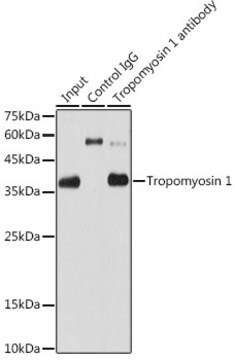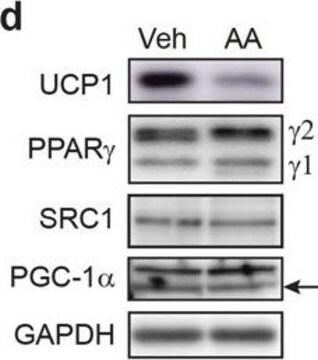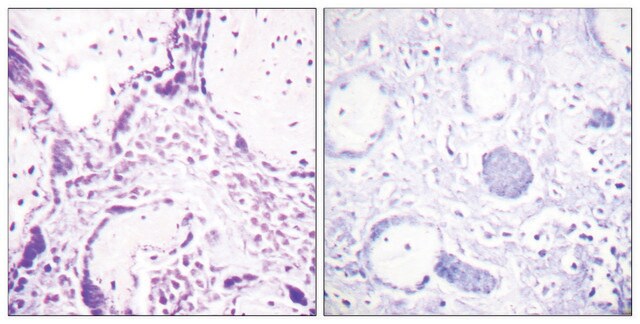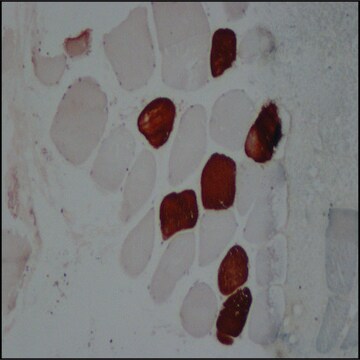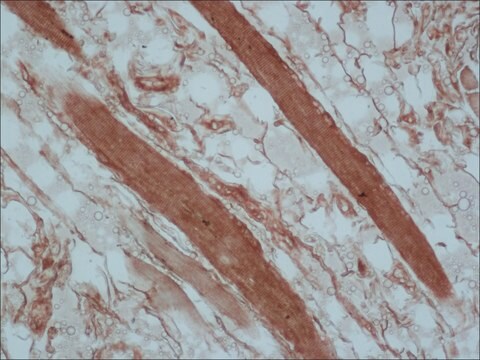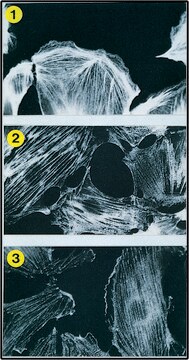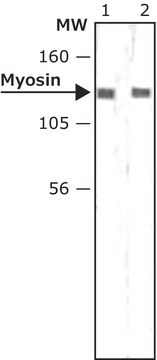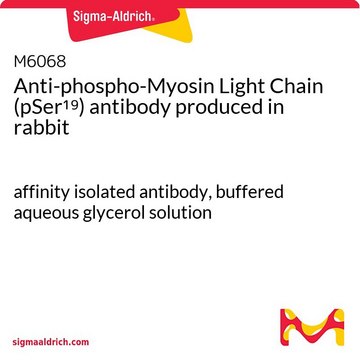AV48224
Anti-TPM2 antibody produced in rabbit
IgG fraction of antiserum
同義詞:
Anti-AMCD1, Anti-DA1, Anti-TMSB, Anti-TropoMyosin 2 (β)
登入查看組織和合約定價
全部照片(2)
About This Item
分類程式碼代碼:
12352203
NACRES:
NA.41
共軛:
unconjugated
application:
IHC
WB
WB
無性繁殖:
polyclonal
物種活性:
human, rabbit, dog, rat, mouse, bovine
citations:
4
技術:
immunohistochemistry: suitable
western blot: suitable
western blot: suitable
推薦產品
生物源
rabbit
品質等級
共軛
unconjugated
抗體表格
IgG fraction of antiserum
抗體產品種類
primary antibodies
無性繁殖
polyclonal
形狀
buffered aqueous solution
分子量
33 kDa
物種活性
human, rabbit, dog, rat, mouse, bovine
濃度
0.5 mg - 1 mg/mL
技術
immunohistochemistry: suitable
western blot: suitable
NCBI登錄號
UniProt登錄號
運輸包裝
wet ice
儲存溫度
−20°C
目標翻譯後修改
unmodified
基因資訊
human ... TPM2(7169)
一般說明
TPM2 codes for beta-tropomyosin that belongs to the actin binding protein family. Mutations in TPM2 have been linked to congenital myopathies, Sheldon-Hall syndrome and cap disease.
Rabbit anti-TPM2 antibody recognizes canine, bovine, rabbit, zebrafish, chicken, human, mouse, and rat TPM2
Rabbit anti-TPM2 antibody recognizes canine, bovine, rabbit, zebrafish, chicken, human, mouse, and rat TPM2
免疫原
Synthetic peptide directed towards the C terminal region of human TPM2
應用
Rabbit anti-TPM2 antibodies have been used for immunoblot analysis. It is also suitable for IHC applications at a concentration of 4-8 μg/ml.
生化/生理作用
TPM2 is beta-tropomyosin, an isoform of tropomyosin that is mainly expressed in slow, type 1 muscle fibers.The TPM2 gene encodes beta-tropomyosin, an isoform of tropomyosin that is mainly expressed in slow, type 1 muscle fibers (Tajsharghi et al., 2007 [PubMed 17846275]). See also TPM1 (MIM 191010), TPM3 (MIM 191030), and TPM4 (MIM 600317).[supplied by OMIM]. Publication Note: This RefSeq record includes a subset of the publications that are available for this gene. Please see the Entrez Gene record to access additional publications.
序列
Synthetic peptide located within the following region: AETRAEFAERSVAKLEKTIDDLEDEVYAQKMKYKAISEELDNALNDITSL
外觀
Purified antibody supplied in 1x PBS buffer with 0.09% (w/v) sodium azide and 2% sucrose.
免責聲明
Unless otherwise stated in our catalog or other company documentation accompanying the product(s), our products are intended for research use only and are not to be used for any other purpose, which includes but is not limited to, unauthorized commercial uses, in vitro diagnostic uses, ex vivo or in vivo therapeutic uses or any type of consumption or application to humans or animals.
未找到適合的產品?
試用我們的產品選擇工具.
儲存類別代碼
10 - Combustible liquids
水污染物質分類(WGK)
WGK 3
閃點(°F)
Not applicable
閃點(°C)
Not applicable
Jung Min Ko et al.
Journal of Korean medical science, 28(5), 780-783 (2013-05-17)
Sheldon-Hall syndrome (SHS) is a rare autosomal dominant, inherited arthrogryposis syndrome characterized by multiple congenital contractures of the distal limbs. To date, four genes that encode the skeletal muscle fiber complex have been confirmed as the causative genes. Mutations in
Minttu Marttila et al.
Human mutation, 35(7), 779-790 (2014-04-03)
Mutations affecting skeletal muscle isoforms of the tropomyosin genes may cause nemaline myopathy, cap myopathy, core-rod myopathy, congenital fiber-type disproportion, distal arthrogryposes, and Escobar syndrome. We correlate the clinical picture of these diseases with novel (19) and previously reported (31)
Vilma-Lotta Lehtokari et al.
Neuromuscular disorders : NMD, 17(6), 433-442 (2007-04-17)
"Cap myopathy" or "cap disease" is a congenital myopathy characterised by cap-like structures at the periphery of muscle fibres, consisting of disarranged thin filaments with enlarged Z discs. Here we report a deletion in the beta-tropomyosin (TPM2) gene causing cap
Carole L Moncman et al.
Experimental cell research, 319(3), 23-31 (2012-11-24)
Extraocular muscles are a unique subset of striated muscles. During postnatal development, the extraocular muscles undergo a number of myosin isoform transitions that occur between postnatal day P10 (P10) and P15. These include: (1) loss of embryonic myosin from the
我們的科學家團隊在所有研究領域都有豐富的經驗,包括生命科學、材料科學、化學合成、色譜、分析等.
聯絡技術服務